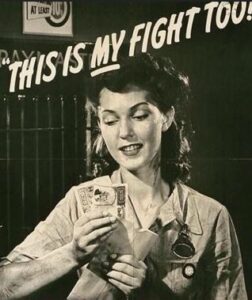 When nations go to war, it is not just the soldiers fighting, who pay the price. War is expensive, and everyone has to help with the war effort. The American people are famous for pitching in when “push comes to shove” and World War II would be no different. On May 15, 1942, the American war effort needed the American citizens to “tighten their belts” so that the funds could be used to help our soldiers. So, gasoline rationing began in 17 Eastern states. It was the first attempt to help the American war effort during World War II. President Franklin D Roosevelt then ensured that by the end of the year, mandatory gasoline rationing was in effect in all 48 states. Things got tougher, and the people felt the pinch, but they were willing to do what was necessary to win the war.
When nations go to war, it is not just the soldiers fighting, who pay the price. War is expensive, and everyone has to help with the war effort. The American people are famous for pitching in when “push comes to shove” and World War II would be no different. On May 15, 1942, the American war effort needed the American citizens to “tighten their belts” so that the funds could be used to help our soldiers. So, gasoline rationing began in 17 Eastern states. It was the first attempt to help the American war effort during World War II. President Franklin D Roosevelt then ensured that by the end of the year, mandatory gasoline rationing was in effect in all 48 states. Things got tougher, and the people felt the pinch, but they were willing to do what was necessary to win the war.
After World War I, many Americans were less than enthusiastic about entering another world war, at least until the Japanese attack on Pearl Harbor on December 7, 1941. The day after the attack, Congress almost unanimously approved Roosevelt’s request for a declaration of war against Japan and three days later Japan’s allies Germany and Italy declared war against the United States. Like it or not, war was on. With the onset of  war, Americans almost immediately felt the impact of the war. The economy quickly shifted from a focus on consumer goods into full-time war production. Everyone was pitching in, and everyone was willing. With so many men in now in the fighting, the women went to work in the factories to replace the now enlisted men, automobile factories began producing tanks and planes for Allied forces and households were required to limit their consumption of such products as rubber, gasoline, sugar, alcohol, and cigarettes. Anything that might be needed for the war effort, was sacrificed by the American people, who felt like it was them just doing their part…for the most part.
war, Americans almost immediately felt the impact of the war. The economy quickly shifted from a focus on consumer goods into full-time war production. Everyone was pitching in, and everyone was willing. With so many men in now in the fighting, the women went to work in the factories to replace the now enlisted men, automobile factories began producing tanks and planes for Allied forces and households were required to limit their consumption of such products as rubber, gasoline, sugar, alcohol, and cigarettes. Anything that might be needed for the war effort, was sacrificed by the American people, who felt like it was them just doing their part…for the most part.
A number of commodities were rationed. Rubber was the first to go, after the Japanese invasion of the Dutch East Indies cut off the US supply. The shortage of rubber, of course affected the availability of products such as tires and anything else that used rubber. Gasoline was a given, because it would be needed to move the troops. Also, it was thought that less gasoline, would bring less travel and therefore less wear and tear on rubber tires. At first, the government urged voluntary gasoline rationing, but by the spring of 1942 it was obvious that people wouldn’t assume that their use was extravagant and not a frivolous use. Hense, first 17 states put mandatory gasoline rationing into effect, and by December, controls were extended across the entire country.
The Government issued ration stamps for gasoline were issued by local boards and pasted to the windshield of  a family or individual’s automobile. The type of stamp determined the gasoline allotment for that automobile. Black stamps signified non-essential travel and so allowed no more than three gallons per week. Red stamps were for workers who needed more gas, including policemen and mail carriers. With the restrictions, gasoline became a hot commodity on the black market, while legal measures of conserving gas, like carpooling, became the norm. Another Government mandated method to reduce gas consumption, the government passed a mandatory wartime speed limit of 35 mph, known as the “Victory Speed.” Things got tight in many areas, but the American people ultimately persevered, and the war effort supplied the needed commodities.
a family or individual’s automobile. The type of stamp determined the gasoline allotment for that automobile. Black stamps signified non-essential travel and so allowed no more than three gallons per week. Red stamps were for workers who needed more gas, including policemen and mail carriers. With the restrictions, gasoline became a hot commodity on the black market, while legal measures of conserving gas, like carpooling, became the norm. Another Government mandated method to reduce gas consumption, the government passed a mandatory wartime speed limit of 35 mph, known as the “Victory Speed.” Things got tight in many areas, but the American people ultimately persevered, and the war effort supplied the needed commodities.


Leave a Reply